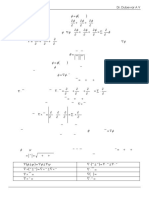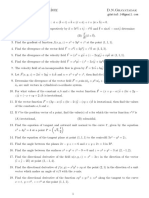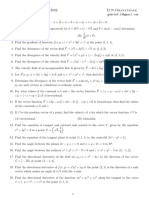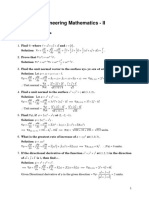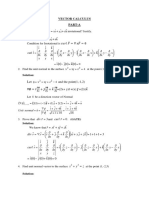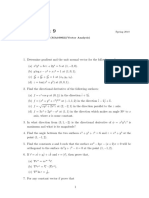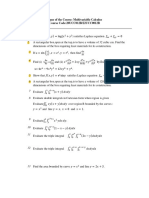Vector Analysis Question Paper
Uploaded by
karthikr90637Vector Analysis Question Paper
Uploaded by
karthikr906371
1. Prove vector identity ∇ × ∇φ = 0.
2. Prove vector identity ∇ × ∇ × A = ∇(∇.A) − ∇2 A.
y x
3. For the vector field A = − x2 +y 2 î + x2 +y 2 ĵ find ∇.A and ∇ × A. Identify the nature of vector field. [Ans0,0
except at the origin]
4. Find constants a, b, c so that V = (x + 2y + az)i + (bx − 3y − z)j + (4x + cy + 2z)k is irrota-
tional.[Ans.a = 4, b = 2, c = −1]
5. For the problem stated above show that V can be expressed as the gradient of a scalar function i.e.
2 2
V = ∇φ(x, y, z). Identify φ(x, y, z) if φ(0, 0, 0) = 0. [Ans.φ = x2 − 3 y2 + z 2 + 2xy + 4xz − yz]
6. If A = 2x2 i − 3yzj + xz 2 k and φ = 2z − x3 y, find A.∇φ and A × ∇φ at the point(1,-1,1). [Ans.5,7i − j − 11k]
7. Find φ(r) such that ∇φ = r
r5 and φ(1) = 0. [Ans. 13 (1 − r13 )]
R
8. If F = (2x + y)i + (3y − x)j, evaluate C F.dr where C is the curve in the xy plane consisting of the straight lines
from (0,0) to (2,0) and then to (3,2).[Ans. 11]
R
9. If F = (5xy − 6x2 )i + (2y − 4x)j, evaluate C F.dr where C is the curve in the xy plane, y = x3 from the point
(1, 1) to (2, 8) [Ans.35]
10. If A = (y − 2x)i + (3x + 2y)j, compute the circulation of A about a circle C in the xy plane with center at the
origin and radius 2, if C is traversed in the positive direction.[Ans.8π]
R
11. (a) If A = (4xy−3x2 z 2 )i+2x2 j−2x3 zk, prove that C A.dr is independent of the curve C joining two given points.
(b) Show that there is a differentiable function φ such that A = ∇φ and find it. [Ans.(b)φ = 2x2 y − x3 z 2 + constant]
RR
12. Evaluate S r.ndS over: (a) the surface S of the unit cube bounded by the cordinate planes x = 1, y = 1, z = 1;
(b) the surface of a sphere of radius a with center at (0, 0, 0). [Ans.(a)3 (b)4πa3 ]
RRR RRR
13. If F = (2x2 − 3z)i − 2xyj − 4xk, evaluate (a) ∇.FdV and (b) ∇ × FdV , where V is the closed region
V V
bounded by the planes x = 0, y = 0, z = 0 and 2x + 2y + z = 4.[Ans.(a) 38 (b) 83 (j − k)]
RR H
14. For the vector field A = − 21 Byi + 12 Bxj verify Stoke’s theorem (∇ × A).n̂dS = A.dl for a circular disk of
S
radius R in xy-plane. [Ans.Both sides πR2 B]
RRR RR
15. For the vector field F = 4xzi − y 2 j + yzk verify divergence theorem ∇.FdV = F.ndS, where S is the
V S
surface of the cube bounded by x = 0, x = 1, y = 0, y = 1, z = 0, z = 1.[Ans.Both sides 32 ]
You might also like
- Problem Sheet - 1: Figure 1. Conduction Band Figure 2. Valance Band0% (1)Problem Sheet - 1: Figure 1. Conduction Band Figure 2. Valance Band2 pages
- Vector Calculus and Co-Ordinate Geometry: X Z y ZNo ratings yetVector Calculus and Co-Ordinate Geometry: X Z y Z1 page
- Previous Year Questions: Vector Analysis (2008-23)No ratings yetPrevious Year Questions: Vector Analysis (2008-23)11 pages
- Vector Analysis Previous Year Questions From 2017 To 1992No ratings yetVector Analysis Previous Year Questions From 2017 To 199210 pages
- Vector Differentiation&Vector Integration QBNo ratings yetVector Differentiation&Vector Integration QB4 pages
- MA5252 Engineering Mathematics-II Unit - INo ratings yetMA5252 Engineering Mathematics-II Unit - I3 pages
- National Institute of Technology Calicut Department of Mathematics MA 1001D: Mathematics 1No ratings yetNational Institute of Technology Calicut Department of Mathematics MA 1001D: Mathematics 12 pages
- Problems For Exercise of Vector CalculusNo ratings yetProblems For Exercise of Vector Calculus19 pages
- Mathocrat Vector analysis PYQs 1992 to 2022No ratings yetMathocrat Vector analysis PYQs 1992 to 202215 pages
- Ma2261 Mathematics Ii UNIT I - Ordinary Differential EquationNo ratings yetMa2261 Mathematics Ii UNIT I - Ordinary Differential Equation17 pages
- Factoring and Algebra - A Selection of Classic Mathematical Articles Containing Examples and Exercises on the Subject of Algebra (Mathematics Series)From EverandFactoring and Algebra - A Selection of Classic Mathematical Articles Containing Examples and Exercises on the Subject of Algebra (Mathematics Series)No ratings yet
- BADENAS y AURELL, 2004 - Sea Level Changes, JabaloyasNo ratings yetBADENAS y AURELL, 2004 - Sea Level Changes, Jabaloyas17 pages
- Request For Quotation of Prices: LFN TradingNo ratings yetRequest For Quotation of Prices: LFN Trading5 pages
- Module-2 Notes Biology For Engineers....No ratings yetModule-2 Notes Biology For Engineers....14 pages
- IMOmath - Functional Equations - Problems With SolutionsNo ratings yetIMOmath - Functional Equations - Problems With Solutions15 pages
- A Path To Greatness: A Book For India BY Dilip RajeevNo ratings yetA Path To Greatness: A Book For India BY Dilip Rajeev512 pages
- Components of The Smart Eye Glasses Price EstimationNo ratings yetComponents of The Smart Eye Glasses Price Estimation2 pages
- Earthworks: Theory and Practice of Surveying Review Innovations100% (1)Earthworks: Theory and Practice of Surveying Review Innovations50 pages
- Brand Awareness & Preference Regarding Havells Green CFL PDF100% (1)Brand Awareness & Preference Regarding Havells Green CFL PDF74 pages
- 3ms All Sequences Lesson Plans Worksheets Tutorial SessionsNo ratings yet3ms All Sequences Lesson Plans Worksheets Tutorial Sessions110 pages
- Sensors: Evolution of RFID Applications in Construction: A Literature ReviewNo ratings yetSensors: Evolution of RFID Applications in Construction: A Literature Review21 pages




